We took a taxi around 9am to the Vatican Museums and checked out the Pope's conveyances on display til our travel mates from the main trip, Iris and John, and our tour guide, Michela, arrived at 10:30. Most of the carriages were pretty fancy, but there were several more subdued ones that appeared to be for traveling. In the early days, apparently the popes rode their own horses too.
 |
Little carriers ranging from fancy to simple. I think the poles
on the back wall were the 'handles' for lifting. |
 |
| The most elaborate of the carriages |
 |
A pope was shot in a vehicle like this, except totally open. After
that, the trucks with the elevated throne to improve the view
all had bulletproof glass. |
With Lodo's help by text messages, we all found each other and got started on our 3-hour tour of a small subset of the Vatican. About half the space inside the walls is well-manicured gardens. From the plaza, we could see the back of St. Peter's Basilica, the largest church in the world and where we ended our tour. One of our main objectives was the Sistine Chapel (no photos, of course) which was our next to last stop as we wound our way through various sections of the museums. Like the Louvre, this is not a place you can do justice to in 3 hours, or even a day, so Michela hit the highlights, ending with the two things we most wanted to see. The museums came about because many popes were collectors and one of the Piuses decided it would be nice if others could see his great stuff. Originally this was limited to fancy people, but now it is a public museum. Our first foray was in some of the outside areas, which included modern pieces along with ancient ones.
 |
| Looking over the plaza to the Basilica and garden |
 |
| Vatican gardens |
 |
When I first saw this, I thought it was a solid
sphere with a reflection. |
 |
Once we walked toward it I could see it was
much more complex. Guides are allowed to
cross the protective chain to demonstrate
how it spins on its axis. |
 |
This pine cone, a symbol of life, used to be a
fountain somewhere. If you look closely at the
bottom of the metal, the dark spots are spouts. |
 |
| There was quite a bit of Egyptian art, including this lion. |
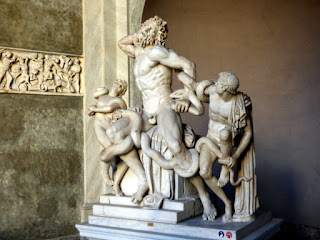 |
Statue of the death of Laocoon and his two sons in Troy. He
was a priest who warned against accepting the wooden horse. |
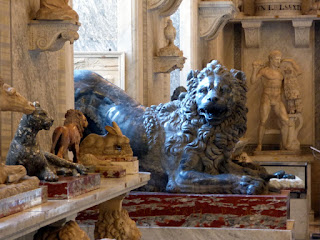 |
| This lion was in one of the animal rooms |
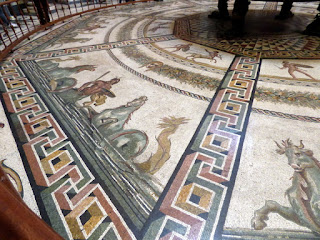 |
Mosaic floor. I am thinking of seeing if I can translate the
geometric border into stained glass., |
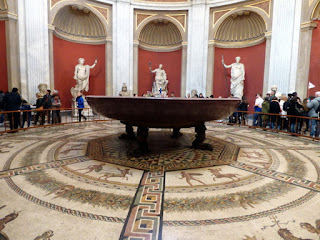 |
| A huge granite basin, brought from Egypt in one piece. |
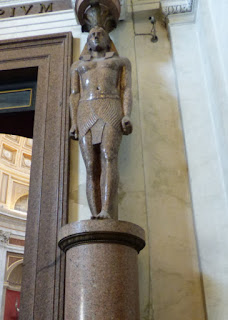 |
| More from Egypt |
 |
| An elaborate sarcophogus |
 |
I am sure we saw this on another trip somewhere:
maybe Turkey. |
 |
| Detail of one of the many tapestries |
 |
In person, this ceiling looks like each section
is sculpted, but it is really just painted to look
that way. |
 |
| One of the most vivid tapestries |
My favorite area was the map corridor, which looked like the same person had painted all the maps. They were all of different areas of Italy, though most of them, oddly, were oriented south to north instead of the more usual format. They were also quite detailed. We were able to see several of the cities we visited on this trip.
 |
| The ceiling of the map room was fabulous too. |
 |
| This map of Sardinia is oriented with south at the top. |
 |
Rome. North is at the left. The Tiber runs left
to right in the bottom half. The Vatican is below
the river and the area where we stayed (Trestevere --
across the Tiber) is where the river curves down
on the right side of the city. |
 |
| Map of Umbria -- reversed -- the west is on the right. |
The thing that surprised me most about the Sistine Chapel was its relatively small size, although the 'chapel' designation should have given a clue. As chapels go, it was pretty big, like a smallish church with every wall and ceiling space painted. What looks like architectural details and curtains are all cleverly done frescoes. I was also not aware that Michelangelo had done nine descriptive frescoes on the ceiling, showing various stages of creation and three about Noah. The famous one of giving life to Adam was way smaller than I had thought. Michelangelo also created an enormous fresco covering the entire front wall showing the last judgement with a very robust (even chunky) Jesus either casting people out of heaven or letting them in. You can see it online here:
http://mv.vatican.va/3_EN/pages/CSN/CSN_Main.html
From there, we went downstairs and into the Basilica, where the altar is located over St. Peter's grave which has sort of been substantiated. The scale is amazing. Michela said the letters at the altar end of the church are each 6 feet tall, though they don't look it. A metal canopy over the altar is 100 feet tall!
This is also where Michelangelo's Pieta is on display, behind a glass wall, necessitated when a man attached the statue with a hammer. Michelangelo completed this amazing work in only 2 years, when he was 24. He was also the last architect of this Basilica, which took 120 years to build and went through several design changes.
 |
Looking out toward th e square from Basilica steps. The metal
things are speakers |
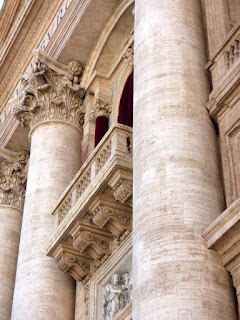 |
The balcony where the Pope appears to give
public addresses |
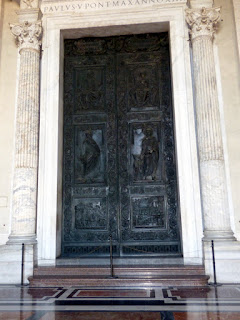 |
| Massive entry doors |
|
 |
Detail from lower right door panel showing St Peter's
crucifixion. He is on the cross head down at his own request
to avoid comparison to Jesus. |
 |
| Inside St. Peter's Basilica |
 |
The Pieta, the only one of his works Michelangelo signed,
etching his name is a fold of Mary's clothing. |
 |
Tomb of John Paul II, one of only two popes in the main body
of the church. |
 |
These letter are 6 feet tall -- look at the size of
the people above |
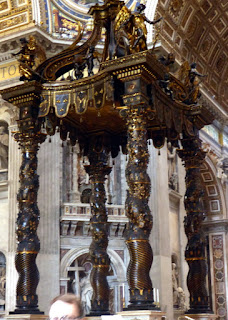 |
| 100 foot tall bronze canopy over the altar |
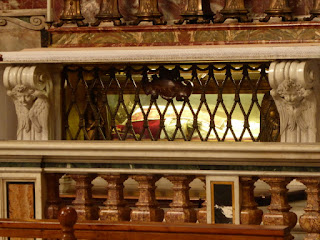 |
| The other pope interred in the main body of the church. |
 |
| Swiss Guards in their winter uniforms |
 |
| The colonnade surrounding St. Peter's Square |
After the tour, we met up with Lodo and Selena and had a wonderful late lunch. Then we took off for our last sight-seeing run. visiting the Pantheon and Trevi Fountain before hiking home. Getting to the fountain around 5 pm was seriously bad timing as the place was a total mob scene. We got a couple photos and headed for the hotel.
 |
On the way to the Pantheon, we passed this fortress, used by
popes when the Vatican was threatened. |
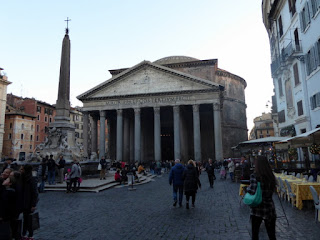 |
Outside of the Pantheon, a former Roman Temple probably
completed about 125 A.D., now a church (since the 7th century) |
 |
| Inside of the Pantheon |
 |
| Trevi fountain and the mob of visitors |
Packing was our evening's challenge -- after the late lunch, dinner was not on the agenda! We have 3 bottles of wine, 3 bottles of creme liquor, 2 small cans and 2 smaller bottles of oil olive to cradle in our suitcases. We also have two terra cotta pots to carry on and cushion so they don't break when we set the bag down or when someone tries to crush it in an overhead! Since our plane is at 7am, we have to leave the hotel by 4 to get there, so this is an early night too.